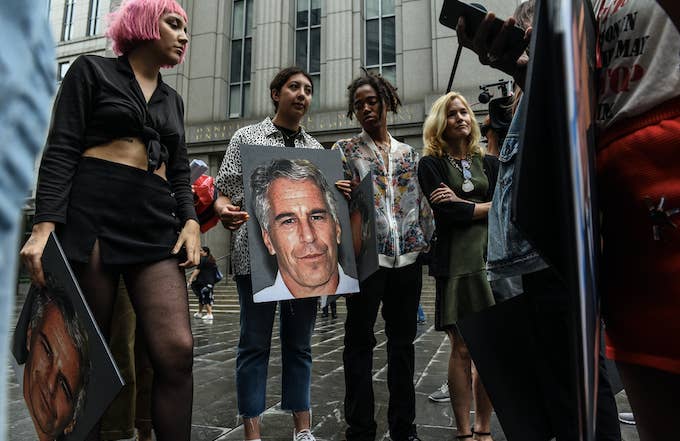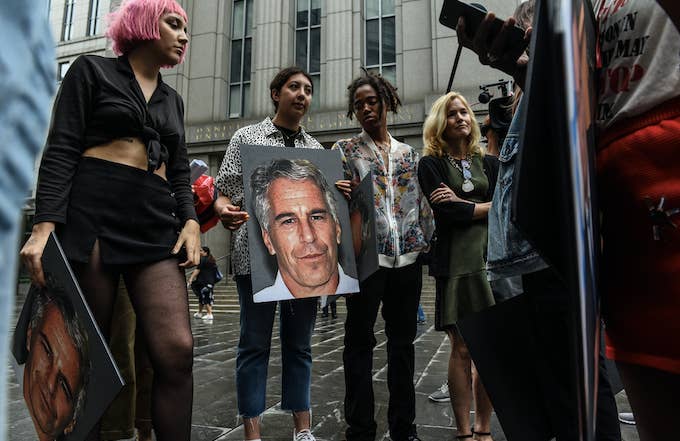
WARNING: GRAPHIC CONTENT BELOW
On Sunday night, 60 Minutes took an extensive look the highly publicized death of disgraced financier Jeffrey Epstein, who died while awaiting trial for child sex trafficking charges. The 66-year-old was found dead on Aug. 10 inside his jail cell at the Metropolitan Correctional Center in New York City. Shortly after his body was discovered, authorities announced that the convicted sex predator had died by apparent suicide. But, of course, the public had its suspicions.
Even before Epstein's death, many suspected his demise would be a result of an orchestrated attack led by wealthy and powerful figures with whom he had ties. Epstein's alleged victims had claimed a slew of elites—including politicians, businessmen, and royals—were not only aware of Epstein's sex trafficking ring, but also participated in it, which meant a trial could've resulted in many more convictions.
Theories of foul play were fueled by suspicious circumstances surrounding the death: Epstein was taken off suicide watch and his cellmate was removed shortly before his death; the guards who were assigned to monitor him reportedly fell asleep as Epstein allegedly hanged himself; and the cameras that were outside Epstein's cell reportedly malfunctioned.
Cameron Lindsay, a former warden who worked at multiple federal facilities, told 60 Minutes that Epstein's death was "a monumental failure on all levels," but insisted there as "absolutely, unequivocally" no way Epstein could've been murdered.
Dr. Michael Baden disagrees and has pointed to evidence that challenges the findings of a suicide. The forensic pathologist references Epstein's purported suicide note obtained by 60 Minutes, stating that the financier wouldn't have received a ballpoint pen if authorities truly believed he was suicidal. Baden, who was hired by Epstein's family to investigate the death and was present during Epstein's autopsy, also told 60 Minutes he had come across a number of inconsistencies during his investigation—specifically the unusual injuries found on Epstein's neck.
"There were fractures of the left, the right, thyroid cartilage and the left hyoid bone," Baden said. "I have never seen three fractures like this in a suicidal hanging. Sometimes there's a fracture of the hyoid bone or a fracture of the thyroid cartilage. Very unusual to have two and not three. And going over— over a thousand jail hangings, suicides in the New York City state prisons over the past 40-50 years, no one had three fractures."
New York officials have contested Baden's theory, claiming these kinds of fractures have been found in both homicides and suicides. According to 60 Minutes, the New York City Medical Examiner's office stands "'firmly' behind their finding of suicide by hanging."
Baden also says the noose Epstein allegedly used to kill himself does not match up with his injuries.
"What I see here is that this noose doesn't match the ligature furrow mark. It's wider than this," he explained.
60 Minutes' Sharyn Alfonsi pointed out that photographs of Epstein's cell appear to show blood in some areas; however, there doesn't appear to be any on the noose.
"That's right. This looks like a clean noose that was never used to compress anybody's neck," Baden responded, before addressing the wounds located on Epstein's lower neck. "Most hangings — especially free hangings the ligature slides up to beneath the jawbone, the mandible. Here it's in the middle of the neck."
Baden told the outlet that the type of neck wound Epstein sustained was more common when someone is strangled with a cord. It's also worth noting that photos obtained by 60 Minutes show cords and wires were present in Epstein's cell after his body was discovered.
"Our job is to find what the truth is. Just to find out whether it's a homicide or a suicide," Baden told Alfonsi. "I hesitate, as usual, to make a final opinion until all the evidence is in."

